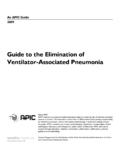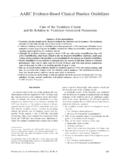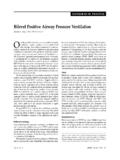Transcription of Continuous Aspiration of Subglottic Secretions in …
1 DOI 2008;134;938-946; Prepublished online July 18, 2008; Chest Mar a Barrio and Javier Hortal Emilio Bouza, Mar a Jes s P rez, Patricia Mu oz, Cristina Rinc n, Jos Postoperative Period of Major Heart SurgeryVentilator- associated pneumonia in theSecretions in the prevention of Continuous Aspiration of Subglottic services can be found online on the World Wide Web at: The online version of this article, along with updated information). ISSN: 0012-3692. (of the copyright holder may be reproduced or distributed without the prior written permission Northbrook IL 60062. All rights reserved. No part of this article or PDFby the American College of Chest Physicians, 3300 Dundee Road, 2007 Physicians. It has been published monthly since 1935. Copyright CHEST is the official journal of the American College of ChestCopyright 2008 by American College of Chest Physicians on November 10, 2008 from Continuous Aspiration of SubglotticSecretions in the prevention ofVentilator- associated pneumonia in thePostoperative Period of MajorHeart Surgery*Emilio Bouza, MD, PhD; Mar a Jesu s Pe rez, RN; Patricia Mun oz, MD, PhD;Cristina Rinco n, RN; Jose Mar a Barrio, MD; and Javier Hortal, MDObjective: Aspiration of endotracheal Secretions is a major step in the prevention of ventilator - associated pneumonia (VAP).
2 We compared conventional and Continuous Aspiration of subglotticsecretions (CASS) procedures in ventilated patients after major heart surgery (MHS).Materials and methods:Randomized comparison during a 2-year :A total of 714 patients were randomized (24 patients were excluded from the study; 359 CASS patients; 331 control subjects). The results for CASS patients and control subjects (perprotocol and intention-to-treat analysis) were as follows: VAP incidence, vs (p )and vs , respectively; incidence density, vs episodes per 1,000 days ofmechanical ventilation (MV) [p ] and vs episodes per 1,000 days of MV,respectively; hospital antibiotic use in daily defined doses (DDDs), 1,213 vs 1,932 (p< ) and1,392 vs 1,932, respectively (p< ). In patients who had received mechanical ventilation for>48 h, the comparisons of CASS patients and control subjects were as follows: VAP incidence, vs (p ), respectively; incidence density, vs episodes per 1,000 daysof MV, respectively (p ); median length of ICU stay, 7 vs days (p ), respectively;hospital antibiotic use, 1,206 vs 1,877 DDD (p< ), respectively;Clostridium difficile- associated diarrhea, vs (p ), respectively; and overall mortality rate, (p ), respectively.
3 Reintubation increased the risk of VAP (relative risk [RR], ;95% confidence interval [CI], to ; p< ), while CASS was the only significantprotective factor (RR, ; 95% CI, to ; p ). No complications related to CASS were observed. The cost of the CASS tube was 9 vs for the conventional :CASS is a safe procedure that reduces the use of antimicrobial agents in the overallpopulation and the incidence of VAP in patients who are at risk. CASS use should be encouraged,at least in patients undergoing MHS.(CHEST 2008; 134:938 946)Key words:intensive care; major heart surgery; prevention ; Subglottic Aspiration ; ventilator - associated pneumoniaAbbreviations:APACHE acute physiology and chronic health evaluation; CASS Continuous Aspiration ofsubglottic Secretions ; CDAD Clostridium difficile- associated diarrhea; CI confidence interval; DDD dailydefined dose; ETA endotracheal Aspiration ; ETT endotracheal tube; EuroSCORE European System for CardiacOperative Risk Evaluation; IQR interquartile range; MHS major heart surgery; MV mechanical ventilation;RR relative risk; VAP ventilator - associated pneumoniaVentilator- associated pneumonia (VAP) is the mostfrequent infection occurring in patients who are ad-mitted to the 3 The accumulation of respiratorysecretions in the Subglottic space is a well-proven cause ofVAP.
4 Therefore, prevention should include the aspirationof Secretions from the Subglottic space, and techniques toavoid leakage between the tube and the tracheal 12A conventional endotracheal tube (ETT) permits onlyintermittent Aspiration of Secretions through the centrallumen, distal to the tracheal cuff, while new tubes with anindependent dorsal lumen permit the Continuous aspira-tion of Secretions in the Subglottic ,9,13 15 CHESTO riginal ResearchPNEUMONIA938 Original ResearchCopyright 2008 by American College of Chest Physicians on November 10, 2008 from Only five randomized prospective studies9,11,12,14,16have assessed the effect of the Continuous aspirationof Subglottic Secretions (CASS) in comparison withconventional Aspiration . The results are inconclusiveFor editorial comment see page 898because the number of patients per study was lim-ited, the population was not homogeneous, and thefinal conclusions regarding efficacy in the preventionof VAP were contradictory.
5 Firm agreement in thisarea has not been reached, and the procedure is notyet common practice among ventilated patients de-spite appearing as a level I recommendation in theCenters for Disease Control and prevention ,17 The incidence of VAP in patients undergoingmajor heart surgery (MHS) is particularly high,ranging from to 21 The only study toanalyze this type of patient, by Kollef et al,14foundno significant reduction in the incidence of VAP withthe implementation of CASS. Our study was a prospec-tive, randomized, comparative study of CASS vs con-ventional intubation and Aspiration in a large popula-tion of patients who were undergoing and MethodsHospital Setting and PatientsOur institution is a general reference hospital with 1,750 bedsand 64,000 admissions per year. The study population includedpatients who underwent MHS from May 2004 to July who gave their informed consent were randomly as-signed to receive either conventional respiratory care or consent was obtained by the anesthesiologist in chargein all cases.
6 Our Ethics Committee approved the study. Aninfectious diseases physician who was aware of the treatmentassignments followed up all patients to check for the presence ofpostoperative Management of ETTs and Respiratory CareRandomization was performed by drawing a card from a sealedenvelope. Thus, patients were intubated during the induction ofanesthesia either with a conventional ETT (Hi-Contour;Mallinckrodt Medical; Athlone, Ireland) or with an ETT withCASS (HI-Lo Evac; Mallinckrodt; Hazelwood, MO). If reintu-bation was required at any time during the postoperative period,patients received the same type of tube to which they wereinitially randomized. Patients in whom tracheostomy was indi-cated at any time were also distributed according to initialrandomization between conventional cannulas (Shiley Low Pres-sure Cuffed Tracheostomy Tube; Tyco Health Care, Mallinck-rodt Medical) or cannulas allowing Subglottic Aspiration (Trache-osost Evac; Mallinckrodt Medical).
7 The size of each ETT wasselected by the attending admission to the ICU, both groups received commonpostoperative care. Tracheal Aspiration through the lumen of theETT was performed as requested by the nurse. Cuff pressure wasmaintained at between 20 and 30 mm Hg, and was controlled andregistered during each admission to the ICU, patients who were randomized to theCASS group were connected to a Continuous system of subglotticaspiration with a negative pressure of between 100 and 150 mmHg. Once per shift, and after checking the cuff pressure, 10 mLof distilled sterile water was instilled through the subglotticlumen in order to keep it patent. If obstruction was present,permeability was reestablished with an air bolus through thesubglottic lumen. All patients received stress ulcer prophylaxiswith RecordedClinical data were recorded according to a preestablishedprotocol, and no systematic surveillance respiratory tract cultureswere performed. The presurgical information that was obtainedincluded epidemiologic data, underlying diseases,22and standardscores (ie, American Society of Anesthesiologists score,23 Euro-pean System for Cardiac Operative Risk Evaluation [Euro-SCORE],24 Charlson comorbidity index,25and acute physiologyand chronic health evaluation [APACHE] II score26on admissionto the ICU).
8 Surgical information included the type of surgery,indication, duration, time spent on cardiopulmonary bypass,aortic cross-clamp time, transfusion needs, reinterventions, anti-microbial prophylaxis, and the need for inotropic support. Anti-microbial prophylaxis for surgery consisted of2gofcefazolin thatwas administered before surgery and every 8 h thereafter for atotal of three doses (patients who were allergic to cefazolinreceived1gofvancomycin before surgery and every 12 hthereafter, up to two doses).Postsurgical outcome events included ICU and hospital lengthof stay, the number of hours patients received mechanicalventilation (MV), and the need for tracheotomy. Infections otherthan VAP were recorded. In patients with sepsis, the Bone scorefor severity of sepsis27was also recorded. The patients who wereenrolled into the study were prospectively followed up for theoccurrence of VAP until they were successfully weaned from MV,discharged from the hospital, or died.
9 Outcome variables alsoincluded antimicrobial administration,Clostridium difficile- associated diarrhea (CDAD), ICU length of stay, ICU mortality,hospital length of stay, and mortality on ICU of VAPVAP was diagnosed in patients who received MV for 48 hwhen the presence of new and/or progressive pulmonary infil-trates was detected on a chest radiograph plus two or more of the*From the Departments of Clinical Microbiology and InfectiousDiseases (Drs. Bouza and Mun oz) and Anesthesiology ( rez, Ms. Rinco n, and Drs. Barrio and Hortal), Ciber deEnfermedades Respiratorias (CIBERES), Hospital General Uni-versitario Gregorio Maran o n, Universidad Complutense, Madrid, research was supported in part by Ciber de EnfermedadesRespiratorias (CIBERES) and by the Rafael del Pino authors have reported to the ACCP that no significantconflicts of interest exist with any companies/organizations whoseproducts or services may be discussed in this received January 13, 2008; revision accepted June 19, of this article is prohibited without written permissionfrom the American College of Chest Physicians ( ).
10 Correspondence to: Emilio Bouza, MD, PhD, Servicio de Micro-biolog a Cl nica y Enfermedades Infecciosas, Hospital GeneralUniversitario Gregorio Maran o n, Dr Esquerdo, 46, 28007 Ma-drid, Spain; e-mail: / 134/5/NOVEMBER, 2008939 Copyright 2008 by American College of Chest Physicians on November 10, 2008 from following criteria: fever (temperature C) or hypothermia(temperature 36 C); leukocytosis ( 12 109cells/L); puru-lent tracheobronchial Secretions ; or a reduction in the Pao2/fraction of inspired oxygen ratio 15% according to Centers forDisease Control and prevention with aclinical pulmonary infection score29 6 were also considered tohave pneumonia . The isolation of one or more pathogenicmicroorganisms in significant bacterial counts was required toconfirm the diagnosis of VAP. We considered as nonpathogenicthe isolation (at any concentration) of the following microor-ganisms, unless proven otherwise: viridans-group streptococci;coagulase-negative Staphylococcus; Neisseria spp; Corynebac-terium spp; and Candida of the lower respiratory tract in cases of suspectedVAP was performed either by endotracheal Aspiration (ETA)and/or telescopic brush sampling of respiratory Secretions .
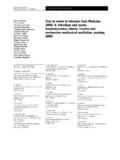
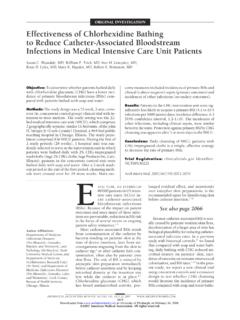
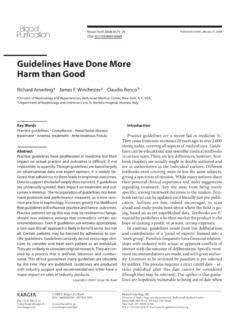
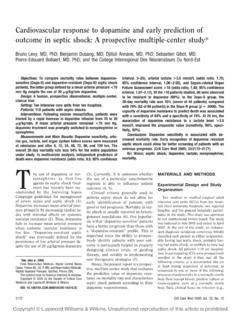
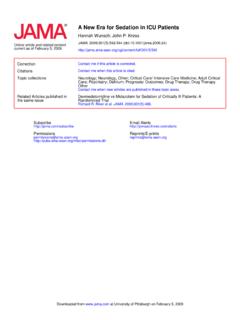
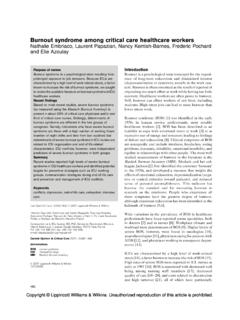
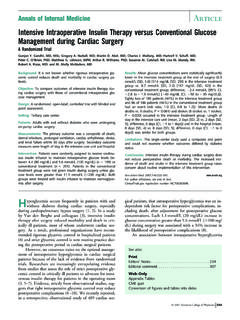
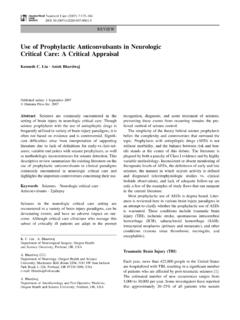
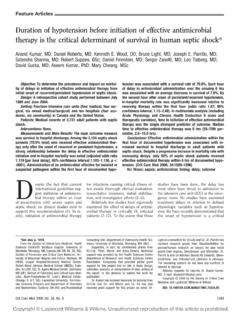
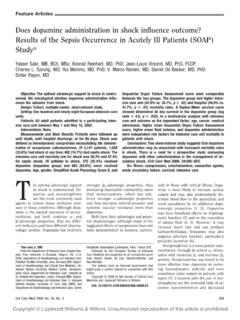
![Pneumonia (Ventilator-associated [VAP] and non …](/cache/preview/d/3/6/5/6/9/b/6/thumb-d36569b6dc8a7d8c6714d2f268ee79b7.jpg)
